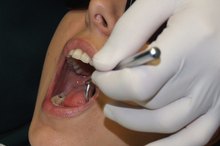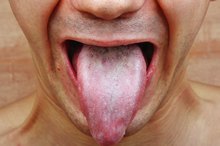Diseases and Disorders of the Tongue
The tongue is a powerful muscle involved in the critical functions of speaking, chewing and swallowing. Taste buds cover the upper surface of the tongue. A variety of diseases and disorders can affect the tongue including infections, injuries, chronic irritation, abnormal tissue growth and congenital conditions. Many tongue disorders are short-lived; others may cause long-term difficulties, requiring ongoing medical management.
Leukoplakia
Leukoplakia is a painless grey or white patch on the tongue that develops in response to chronic irritation. These patches can also develop on the inner cheek regions of the mouth. Cigarette or pipe smoking and use of chewing tobacco increase the risk for development of leukoplakia. Irritation caused by poorly fitting dentures or rough spots on the teeth can also lead to leukoplakia. The University of Texas M.D 1. Anderson Cancer Center reports that approximately one-quarter of leukoplakia patches are cancerous or precancerous 1. A variant of this disorder known as hairy leukoplakia is caused by the Epstein-Barr virus, and mostly commonly occurs in people with a weakened immune system.**
- Leukoplakia is a painless grey or white patch on the tongue that develops in response to chronic irritation.
- Irritation caused by poorly fitting dentures or rough spots on the teeth can also lead to leukoplakia.
Macroglossia
Causes of Tongue Discoloration
Learn More
Macroglossia describes abnormal tongue enlargement. This condition can cause misalignment of the teeth and speech difficulties. Macroglossia often occurs with certain congenital or inherited conditions, including Down syndrome, Beckwith-Wiedemann syndrome, acromegaly, congenital hypothyroidism and primary amyloidosis. Macroglossia can also occur due to tongue swelling or abnormal tissue growth caused by a variety of disorders including multiple myeloma, sarcoidosis, tongue tumors and certain infections.
- Macroglossia describes abnormal tongue enlargement.
- Macroglossia can also occur due to tongue swelling or abnormal tissue growth caused by a variety of disorders including multiple myeloma, sarcoidosis, tongue tumors and certain infections.
Glossitis
Glossitis is inflammation of the tongue, which may be transient or chronic. The tongue may swell, and the surface characteristically appears smooth and red or abnormally pale. Tenderness and burning commonly occur, which may interfere with speaking, chewing and swallowing. Taste disturbances often accompany glossitis. Transient episodes of glossitis may occur due to burning the tongue with hot foods or liquids, oral herpes, thrush and allergic reactions to mouthwash, toothpaste or the plastics in dental appliances such as retainers or dentures. Persistent glossitis can occur with vitamin B12 and folic acid deficiencies, iron deficiency anemia, syphilis, oral lichen planus and aphthous ulcers.
- Glossitis is inflammation of the tongue, which may be transient or chronic.
- Transient episodes of glossitis may occur due to burning the tongue with hot foods or liquids, oral herpes, thrush and allergic reactions to mouthwash, toothpaste or the plastics in dental appliances such as retainers or dentures.
Tongue Cancer
Signs of Lip Cancer
Learn More
Tongue cancer is a form of head and neck cancer. Cancers of the forward two-thirds of the tongue are oral tongue cancers. Those at the back of the tongue are tongue base cancers. Tongue cancers usually present as a lump or a nonhealing ulcer. The American Cancer Society reports that more than 13,500 cases of tongue cancer occur annually in the United States, with squamous cell carcinoma as the most common form of the disease 4. Smoking, use of chewing tobacco and excessive alcohol consumption increase the risk for the development of tongue cancer.
- Tongue cancer is a form of head and neck cancer.
- Those at the back of the tongue are tongue base cancers.
Related Articles
References
- University of Texas M.D. Anderson Cancer Center: Oral Cancer
- Family Practice Notebook: Macroglossia
- Handbook of Oral Disease: Diagnosis and Management; Crispian Scully, M.D., Ph.D., M.D.S.; 2001
- American Cancer Society: Cancer Facts and Figures 2013
- American Family Physician. Assessing Oral Malignancies. https://www.aafp.org/afp/2002/0401/p1379.html
- Paderno A, Morello R, Piazza C. Tongue carcinoma in young adults: a review of the literature. Acta Otorhinolaryngol Ital. 2018;38(3):175-180. doi: 10.14639/0392-100X-1932
- Sultana J, Bashar A, Molla MR. New Management Strategies of Oral Tongue Cancer in Bangladesh. J Maxillofac Oral Surg. 2014;13(4):394-400. doi: 10.1007/s12663-013-0566-8
- Ram H, Sarkar J, Kumar H, Konwar R, Bhatt ML, Mohammad S. Oral cancer: risk factors and molecular pathogenesis. J Maxillofac Oral Surg. 2011;10(2):132-7. doi: 10.1007/s12663-011-0195-z
- Kim SM. Human papilloma virus in oral cancer. J Korean Assoc Oral Maxillofac Surg. 2016;42(6):327-336. doi: 10.5125/jkaoms.2016.42.6.327
- Center for Disease Control. Human Papillomavirus (HPV) and Cervical Cancer: An Update on Prevention Strategies Script. cdc.gov/std/hpv/hpvscript.pdf
- Oral Cavity and Oropharyngeal Cancer. American Cancer Society. https://www.cancer.org/cancer/oral-cavity-and-oropharyngeal-cancer.html.
- Genital HPV Infection - Fact Sheet. Centers for Disease Control and Prevention. https://www.cdc.gov/std/hpv/stdfact-hpv.htm.
Writer Bio
Dr. St. John is a medical writer and editor with more than 15 years experience in the field. She is a former medical officer for the Centers for Disease Control and Prevention.








